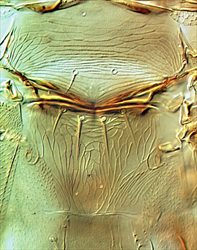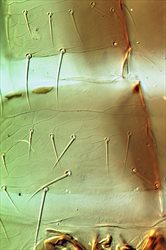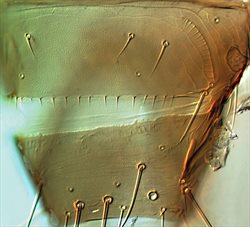
Fore tibia & tarsus

Fore tibia & tarsus

Meso & metanota

Metanotum

Sternite VII

Tergites VIII-IX

Tergite VIII
Female fully winged. Body and legs brown, tarsi and tibial apices yellow, antennal segment III and apex of II mainly yellow, IV light brown, V–VII brown; fore wings weakly shaded with base pale. Antennae 7-segmented; III–IV each with forked sense cone. Head with 2 pairs of ocellar setae; pair III small, arising inside ocellar triangle; postocular setae pairs I & III longer than ocellar setae III, postocular setae pair II minute. Pronotum with widely spaced transverse reticulate lines, 2 pairs of posteroangular setae; posterior margin with 3 pairs of setae. Mesonotum with anterior campaniform sensilla, median setae far in front of posterior margin. Metanotum with longitudinal reticulation medially; median setae arising near anterior margin; campaniform sensilla present. Fore tarsus inner apex with recurved claw. Fore wing first vein with about 3 setae on distal half; second vein with about 11 setae. Abdominal tergite II with 4 lateral marginal setae; tergites V–VIII with paired ctenidia, on VIII posteromesad to spiracles; tergite VIII posteromarginal comb of microtrichia complete but microtrichia short and widely spaced; tergites III–VI with no sculpture lines mesad of setae S2; pleurotergites without discal setae, no microtrichia on sculpture lines, but a few on posterior margin; tergite IX with 2 pairs of campaniform sensilla, X with median split. Sternites III–VII with 5–8 discal setae in single row.
Male unknown.
The genus Thrips is the second largest genus in the Thysanoptera, and currently includes, worldwide, over 290 species. All members of genus Thrips lack ocellar setae I on the head, and they all have ctenidia on tergite VIII posteromesad to the spiracles. Other characters, such as number of antennal segments, number of setae on the fore wing veins, and number of discal setae on the sternites are variable between species (Palmer, 1992; Nakahara, 1994; Mound & Masumoto, 2005). Thrips calcaratus is unusual within the genus Thrips in having a small claw at the inner apex of the fore tarsus, but apart from that it shares many character states with Thrips physapus, the type species of this genus.
Feeding and breeding on the leaves of its host plants, and largely specific to species of Tilia [Tiliaceae].
Locally common in Britain, though yet to be recorded from Wales, this thrips is apparently more common from northern England to northern Scotland (Mound et al., 1976). It is also found in Scandinavia and is widespread from France to Bulgaria. It has also been introduced into North America and has been reported there as a pest of Tilia americana (Raffa & Hall, 1989).
THRIPIDAE - THRIPINAE
Thrips calcaratus Uzel
Thrips calcaratus Uzel, 1895: 195
Mound LA & Masumoto M (2005) The genus Thrips (Thysanoptera, Thripidae) in Australia, New Caledonia and New Zealand. Zootaxa 1020: 1–64.
Mound LA, Morison GD, Pitkin BR & Palmer JM (1976) Thysanoptera. Handbooks for the Identification of British Insects 1 (11): 1–79.
Nakahara S (1994) The genus Thrips Linnaeus (Thysanoptera: Thripidae) of the New World. United States Department of Agriculture. Technical Bulletin 1822: 1–183.
Palmer JM (1992) Thrips (Thysanoptera) from Pakistan to the Pacific: a review. Bulletin of the British Museum (Natural History) Entomology Series 61 (1): 1–76.
Raffa KF & Hall DJ (1989) Thrips calcaratus Uzel (Thysanoptera: Thripidae), a new pest of basswood trees in the Great Lakes region. Canadian Journal of Forest Research 19: 1661–1662.